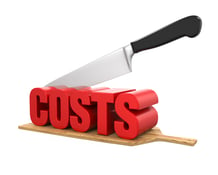Let’s get the bad news out of the way first: the average profit margin for restaurants is one of the lowest in all industries; factoring in the drastic impacts the global pandemic is having on the restaurant and hospitality industry as a whole, these margins can be even slimmer.
Now the good news! There is plenty your restaurant can do to improve on these grim statistics. Not to mention, narrowing in on your own specific percentage baseline (as no two restaurants are exactly the same).
In this article, we will discuss the following:
What exactly are restaurant profit margins
How to calculate your restaurant’s profit margins
What is the average restaurant profits margin
How to increase your restaurant’s profit margins
Now let’s get to it!
What Is A Profit Margin?
The most important thing restaurants need to remember about profit margins -- aside from, you know, paying serious attention to them -- is that there are two very distinctive types: gross profit margin and net profit margins. And since both are pretty darn important, let’s go ahead and clear up the confusion between the two right now:
Gross Profit Margin = Total Sales - Costs of Goods Sold
The number you’re left with after deducting all your costs of goods sold (COGS) -- food, beverage, etc. -- is your gross profit; your go-to figure when quantifying product costs, efficiency, etc.
Net Profit Margin (%) = (Net Profit / Revenue) x 100
This number, arguably the most important, is what’s left after you deduct all costs of running your business -- think everything from rent and utilities to payroll, insurance and taxes -- from your gross profit. In other words, this determines how much money (if any!) your restaurant is in fact earning. So if your “net profit margin” is 8%, that means for every dollar a customer spends, you’re pocketing 8 cents of it as profit.
What’s An Average Profit Margin for Restaurants?
Now that you know what makes up a profit margin, it should come to no surprise that there is no “one-size-fits-all” when it comes to a restaurant’s profit margin. Aspects like whether it’s full-service, fast-casual or offers catering all play a huge factor. For instance, full-service typically requires the most staff and therefore tends to have the lowest average profit margins (between 3-5%) whereas catering can be upwards of 7-8% and fast food or food trucks between 6-9%.
How Do I Improve My Restaurant’s Profit Margin?
Simple! Just increase your sales volume and decrease your overhead expenses. Just kidding, it’s not simple at all. But there are steps and strategies you can implement that make a huge difference.
Increase sales by:
Getting on social media: According to TripAdvisor, more than 90% of consumers research a restaurant before visiting it. So in other words, your online presence is critical; that includes, ensuring you have a solid social media strategy (including responding to online reviews!) in place.
Improving your efficiency: Is your space maximized? How easily can guests be seated and served? How swiftly your restaurant operates has a lot to do with its floorplan, so make sure yours is done right.
Stepping up your POS game: Speaking of efficiency, long gone are the days in which your POS system is just for transactions. It can also serve as a “hub” for your restaurant’s technology, including detailed insights and analytics pertaining just to your establishment that can help increase productivity for your business across the board.
Embracing online ordering: These days, the “dining in” landscape changed extremely rapidly; meaning, online ordering and takeout options as a whole have never been more imperative. Not just having this option -- which goes without saying since this is at times the only option -- but making it as simple as possible to ensure repeat customers.
Evaluating your menu layout: you may not realize it, but how your menu is formatted can actually drive sales. For instance, research shows the pattern of your eyes tends to gravitate towards the middle (aka the “golden triangle”) of the menu and is therefore likely where your restaurant’s most viewed items will live (so beef it up with your signature, top ticket items!).
Decrease overhead by:
Staying on top of COGS: Remember what COGS stands for? Good! (Also, if not, just scroll up.) Since it’s what pretty much all restaurants’ funds go towards, finding ways to reduce them -- i.e. utilizing every scrap of product on your menu, keeping an active inventory list as well as sourcing new vendors accordingly -- is one the biggest money savers. Pro tip: Try a “food cost calculator.”
Monitor utilities closely: Saving money in your restaurant can be as easy as making sure to turn all electronics off, and before you roll your eyes, think about when you’re trying to save money on your home power bill. Now, consider the fact restaurants can consume up to ten times more energy per square foot than any other commercial building; oh, and that a utility bill can account for 33% of a restaurant’s sales. Ready to start turning those lights off religiously?
Evaluate employee schedules: Who has time -- especially in the restaurant industry! -- to stay on top of a spreadsheet? Even if you do, things can easily fall through the cracks; staffing ineffectively can waste tons of money if overlooked. Especially when staff can be done within comprehensive software, which also allows managers to stay on top of paid time off, sick leave as well as potential early check-ins or check-outs.
Invest In Your Team: While turnover in the restaurant industry is inevitable, it’s also quite costly to retrain new staff. And since a successful business is also as strong as the team in place, try to reduce staff turnover as much as possible by investing in strong members of your team. Your employees will feel more appreciated, ultimately be more loyal -- and trust us -- it will save your restaurant money (and incalculable closets to your sanity) in the long run.
[Photo: energepic.com from Pexels]





